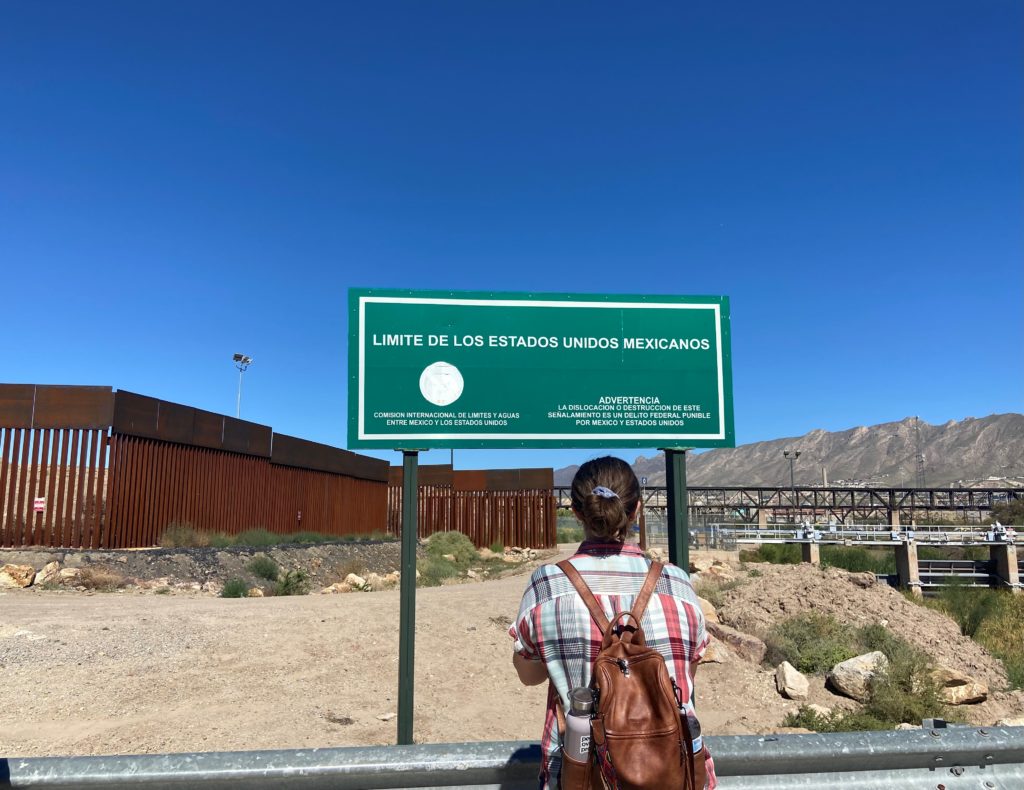To really fall in love with a place, you have to get to know the people. You have to choose proximity. You have to choose to participate.
At the border in late October, thanks to women of faith from across the U.S. and visits to two contrasting migrant shelters, I fell in love with not only the place but the stories of the people.
All of the women on our border trip live their own lives, and yet we all decided to come to the edge of the country for a few days to try to better understand what is happening at our borders and in our communities. We wanted to see for ourselves the challenges along the border, the byproducts of border walls (in this case, reddish-brown, rustic-steel, 18-foot-tall bars with barbed wire at the top and sensors at the bottom), and the contrasting beauty of the place. Here, border communities offered us smiles and color, games and home-cooked food, love, and laughter.
And yet, we were constantly reminded why we were here: to be open-minded and to learn. Everyone on the trip understood some of the painful reasons people are migrating, leaving their native homes, families and friends, and livelihoods. Among those reasons are gang threats to their families, cartels part of a multibillion-dollar transnational criminal network preying on the vulnerable; food and economic insecurity; poverty; corruption; climate change; and more. Despite these dangers and hardships, only some are allowed to enter the United States.
Everyone in our group had a drive to learn, to listen, to be vulnerable and share stories. Failures and successes. Questions and answers. Examples of love and welcome, hate and displacement, challenges, and solutions.
The need for congressional action to improve our border and immigration policies moves from abstract to very real when you’re at the border. So too does the need to continue building sustained engagement and partnerships with Mexico. I felt it in our conversations, and workshops about policy, history, asylum processes and the physical border.
So many Americans would benefit from what this trip required of participants: a commitment to choose proximity, learning, and understanding the intricacies of a deeply complex system in need of broad reforms.
But the “system” is not the point — the people are. In committing to and choosing proximity to immigrants and migrants, we can fall in love with both the people and the places where they converge. With deep love comes care and honoring human dignity, regardless of immigration status.
Let us remember that it is a blessing that immigrants want to come to the U.S. — to our home. It’s a blessing that migrants who make the journey north want to continue building their lives and our nation with their presence — an ultimate gift. It is a blessing to build bonds across perceived and real divides, across multicultural and multifaceted places, and among beautiful, deserving new neighbors.
Once upon a time, we too were new to a place and community. We too wanted respect and welcome, humanity and dignity, love, and care, understanding and empathy. We too were just there — coming to a new place as strangers in El Paso and Juárez — and now we’ve had the opportunity to experience an inkling of what migrants feel in an unknown territory as they seek refuge and support.
This ongoing reflection comes as the Supreme Court just paused the pending lift of Title 42. Used during the pandemic, the policy effectively blocked hundreds of thousands of migrants from seeking asylum in the U.S., whom were then rapidly expelled to Mexico.
While we have these policy conversations and immersive border experiences, we must keep in mind the real people whom our policies affect. The end of Title 42 is likely to increase the number of migrants coming to the border, and the U.S. must prepare to support them with an immigration system that reflects compassion, dignity and respect.
As we continue exploring how we can imagine and create a just border and simultaneously pursue narrative, personal, world, and political change within and for immigration, I remember — and don’t want to forget — three things our border guides, from the Texas nonprofit Abara, taught us:
- The issue is not a border wall but the systems in place to manage the border — as they consistently fail to balance security with compassion for migrants and immigrants.
- Asking permission to share migrants’ and other people’s stories, photos, and lives is essential. It gives them the power to say yes or no — since it’s their story to tell. It respects their wishes and diminishes ramifications that could hurt their pursuit of happiness, peace, and ease on their journey. Abara described this as dignified storytelling.
- A just border is possible. Through community, solidarity, conversations with authority, meaningful interactions, and immersions with migrants, sharing a space with advocates and policymakers, education, reading and listening — immersion trips like these allow us to actively make the border more just as we choose to get closer to it, its people, its place.
This Christmas season and into next year, I hope we can all take these lessons to heart, better empathize with the challenges everyone involved in our border situation is experiencing, and realize the beauty of welcoming the stranger.


